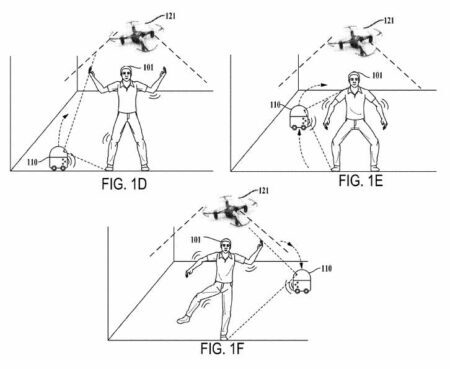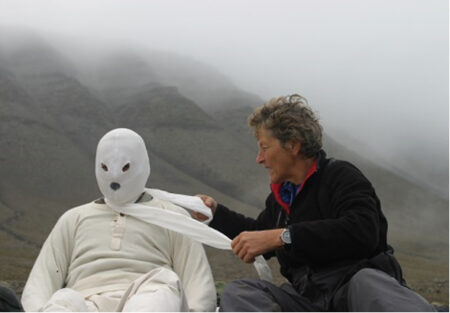Marc Abrahams's Blog, page 67
November 12, 2021
Nadiya Slobodenyuk joins Luxuriant Flowing Hair Club for Scientists (LFHfC)
Nadiya Slobodenyuk has joined the The Luxuriant Flowing Hair Club for Scientists (LFHCfS). She says:
(LFHCfS). She says:
For a while, I researched why we have a subjective experience of being able to initiate actions and control our bodies (until it’s time to get out of bed and exercise…). I have also researched why high-pitched sounds are sweet and sour, rounded shapes smell like vanilla, and darker colors feel more adhesive. Currently, I teach cognitive science students about human, animal, and machine minds, and how to conduct research.
Nadiya Slobodenyuk, Ph.D., LFHCfS
Cognitive Science InstructorDepartment of Cognitive Science, Carleton University
Ottawa, Canada

November 11, 2021
Can You Navigate in a Crowd, While Distracted by Your Mobile Phone?: 2021 Ig Informal Lecture
The Ig Nobel Prizes honor achievements that make people LAUGH, then THINK.
In the Ig Informal Lectures, some days after the ceremony, the new Ig Nobel Prize winners attempt to explain what they did, and why they did it. We are releasing these lectures one at a time.
The 2021 Ig Nobel for Kinetics was awarded to Hisashi Murakami, Claudio Feliciani, Yuta Nishiyama, and Katsuhiro Nishinari, for conducting experiments to learn why pedestrians do sometimes collide with other pedestrians.
REFERENCE: “Mutual Anticipation Can Contribute to Self-Organization in Human Crowds,” Hisashi Murakami, Claudio Feliciani, Yuta Nishiyama, and Katsuhiro Nishinari, Science Advances, vol. 7, no. 12, 2021, p. eabe7758.
November 10, 2021
Effect of Sex-With-Strangers on Sand Dunes
A new study about erosion might attract more attention than most studies about erosion. It is:
“Sand, Sun, Sea and Sex with Strangers, the “five S’s.” Characterizing “cruising” activity and its environmental impacts on a protected coastal dunefield,” Leví García-Romero, Carolina Pena-Alonso, Patrick A. Hesp, Antonio I. Hernández-Cordero, and Luis Hernández-Calvento, Journal of Environmental Management, vol. 301, January 1, 2022, no. 113931. (Thanks to Tom Gill for bringing this to our attention.) The authors, at Universidad de Las Palmas de Gran Canaria, Spain, and Flinders University, Australia, report:
“Cruising” is a concept which designates a practice of social interaction that consists of anonymous sexual encounters, mostly among homosexuals, in open and/or closed public spaces. Coastal dunes and beaches are examples of open public spaces where these sexual practices are widely carried out, to the extent that the so-called “Four S’s” (Sand, Sun, Sea and Sex) have even been defined in the literature…. In this work, the spatial distribution and the environmental impacts of cruising in a protected coastal dune system are characterized and assessed….
The results show that the distribution of the 298 identified sex spots, which occupy an area of 5763.85 m2, is related to the distance to authorized paths in the protected area, to the presence of bushy and dense vegetation, and to stabilized aeolian landforms or ones formed by vegetation (nebkhas)…. The activities developed in these sex spots impact directly on the aeolian landforms and on eight native plant species, three of which are endemic species.
Duck Body Parts
The review article “Duck Body Parts” (which you can download) is part of the special Ducks issue (volume 27, number 4) of the magazine, Annals of Improbable Research.
This special issue, like many other special issues of the magazine, is also available for purchase. All the issues are in the form of downloadable PDFs.
November 9, 2021
The Man Who Disguised Himself as a Polar Bear
Eigel Reimers, who shared a 2014 Ig Nobel Prize with Sindre Eftestøl, for testing how reindeer react to seeing humans who are disguised as polar bears, tells all about it, in an essay he wrote for the Norwegian Polar Club. It says, in part:
The question hung in the air and hung there: had the bear been on an unsuccessful reindeer hunt or was it a pure coincidence that one of the bears we had seen on some occasions in the areas was suddenly in the heart of Plurdalen? In a sense, we got an answer in the next couple of days. We returned to the base and Kristin and Mikkel who were informed over the radio about what we had observed and were in the process of preparing a disguise stunt.
We found everything we had of white equipment that included a white hat, white sports tape, white anorak, a yellow-white long down pants that could be pulled down over the boot shafts to over the ankle and white dope paper that could seal imperfections. Holes were cut in the hat for the eyes and a black snout was painted. I was to be a polar bear in our immediately improvised and creative attempt: to provoke Svalbard reindeer as a polar bear in order to be able to compare the different fear and flight distances with those we had measured with humans as provocateurs….
For a more formal report about this, see their study “Response Behaviors of Svalbard Reindeer towards Humans and Humans Disguised as Polar Bears on Edgeøya,” Eigil Reimers and Sindre Eftestøl, Arctic, Antarctic, and Alpine Research, vol. 44, no. 4, 2012, pp. 483-9.

November 8, 2021
‘Robot As Personal Trainer’ [new patent]
The ever-expanding list of professions which might soon be replaced by hi-tech. solutions is still growing strong. Sony Interactive Entertainments Inc. (Tokyo) has just been granted a US patent for its Robot As Personal Trainer
Embodiments of the present invention disclose methods and systems that are used to assist a user to perform an activity, such as a physical training, with the help of a robot.
[…]
When the robot detects that the user is engaged in an exercise routine either based on the schedule followed by the user or based on explicit instructions received from the user, the robot moves into one or more positions proximal to the user so that the robot can capture images of a posture and motion of the user while the user is performing an exercise from the exercise routine.
[…]
The robot then provides feedback so as to assist the user in correcting the posture or movement for the different exercises defined in the exercise routine. The robot may continue monitoring the actions and motions of the user and provide additional feedback.
[…]
The robot thus acts as a “Personal Trainer” providing feedback to the user, just like a real-life personal trainer, as the user is performing the exercise by capturing different angles of a posture and providing feedback on the posture.
Patent research Martin Gardiner

November 5, 2021
Janne Cadamuro joins Luxuriant Flowing Hair Club for Scientists (LFHfC)
Janne Cadamuro has joined the The Luxuriant Flowing Hair Club for Scientists (LFHCfS). He says:
(LFHCfS). He says:
I endeavored a medical career ending up in a hospital laboratory as the tech/lab geek I am. As such I am evaluating laboratory diagnostic algorithms, including the use of artificial intelligence, still struggling to find a better way of diagnostic healthcare. My vision: Scotty’s medical tricorder. Until then I will continue researching improbable ways of making the patients path through this awkwardly complex medical system hopefully a little easier.
As additional field of research I am investigating the impact of three kids on the mental health of an Austrian/Italian/Swedish married couple (n=1, study period so far: 5016 days and counting).
Priv. Doz. OA Dr. Janne Cadamuro EuSpLM, LFHCfS
Uniklinikum Salzburg / Landeskrankenhaus
Universitätsinstitut für Medizinisch-Chemische Labordiagnostik und medizinische Mikrobiologie der PMU
Salzburger Landeskliniken
Salzburg, Austria


November 4, 2021
Why Pedestrians Do Not Constantly Collide: 2021 Ig Informal Lecture
The Ig Nobel Prizes honor achievements that make people LAUGH, then THINK.
In the Ig Informal Lectures, some days after the ceremony, the new Ig Nobel Prize winners attempt to explain what they did, and why they did it. We are releasing these lectures one at a time.
The 2021 Ig Nobel for Physics was awarded to Alessandro Corbetta, Jasper Meeusen, Chung-min Lee, Roberto Benzi, and Federico Toschi, for conducting experiments to learn why pedestrians do not constantly collide with other pedestrians.
REFERENCE: “Physics-based modeling and data representation of pairwise interactions among pedestrians,” Alessandro Corbetta, Jasper A. Meeusen, Chung-min Lee, Roberto Benzi, and Federico Toschi, Physical Review E, vol. 98, no. 062310, 20188.

Gareth Jones: Fellatio in Fruit Bats, and Beyond
Bat Chat, the podcast produced by the Bat Conservation Trust, visited with Ig Nobel Prize winner Gareth Jones. The 2010 Ig Nobel Prize for Biology was awarded to Libiao Zhang, Min Tan, Guangjian Zhu, Jianping Ye, Tiyu Hong, Shanyi Zhou, and Shuyi Zhang of China, and Gareth Jones of the University of Bristol, UK, for scientifically documenting fellatio in fruit bats.
The team documented that prize-winning research, in their study “Fellatio by Fruit Bats Prolongs Copulation Time,” Min Tan, Gareth Jones, Guangjian Zhu, Jianping Ye, Tiyu Hong, Shanyi Zhou, Shuyi Zhang and Libiao Zhang, PLoS ONE, vol. 4, no. 10, e7595.
Bat Chat says about this podcast episode:
Steve is on the roof of the biological sciences building with Professor Gareth Jones where he talks to Steve about just some of the research he has undertaken in his lifetime with bats. They discuss the work famously done to separate the two pipistrelle species back in the 90’s, what Gareth gets up to in his spare time and the unusual behaviour found in fruit bat species which won Gareth the Ig Nobel Prize! Please leave us a review if you can, it helps us to reach a wider audience so that we can spread the word about how great bats are.

November 3, 2021
Uranium for Ducks
The review article “Uranium for Ducks” (which you can download) is part of the special Ducks issue (volume 27, number 4) of the magazine, Annals of Improbable Research, has flown its way to subscribers.
This special issue, like many other special issues of the magazine, is also available for purchase. All the issues are in the form of downloadable PDFs.

Marc Abrahams's Blog
- Marc Abrahams's profile
- 14 followers








